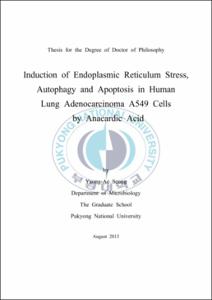Induction of Endoplasmic Reticulum Stress, Autophagy and Apoptosis in Human Lung Adenocarcinoma A549 Cells by Anacardic acid
- Abstract
- Anacardic acid (2-hydroxy-6-pentadecylbenzoic acid, AA) is a constituent of the cashew-nut shell as well as several other plants including Ginkgo biloba. AA displays a variety of beneficial properties including its anti-microbial effects and capacity to treat cancer. In addition, AA has been used as a traditional medicine for treatment of gastric ulcers, gastritis, and stomach cancers in many localized regions of the world including Mexico. Although it is known that AA suppresses the expression of nuclear factor-κB-regulated genes, the molecular mechanism of cell death in AA-treated cancer cells is not clear.
This research was conducted to investigate AA’s anti-cancer effect and to reveal the possible pathway by which it induces cell death. While AA exhibited cytotoxic activity in all cancer cells used in this research, the degree of cytotoxicity was different depending on the cell lines. Considering our interest in lung cancer, we used A549 cells (lung adenocarcinoma derived from human alveolar basal epithelial cells) to reveal the molecular mechanism of cell death. Currently, the collective evidence indicates that AA induces UPR (unfolded protein response), endoplasmic reticulum stress, autophagy and apoptotic cell death. The results of Ca2+ mobility, transmission electron microscopy (TEM), Western blot, gene transfection, fluorescence activated cell sorting (FACS) and staining with 4', 6-diamidino-2-phenylindole (DAPI) showed clear evidence of the induction of the unfolded protein response, autophagy and apoptosis in AA-treated cells.
The efflux of Ca2+ from the ER to the cytosol, the increase of misfolded or unfolded proteins in the ER lumen by reduced p-PERK, the activation of ATF6 and the increase of IRE1α may activate the UPR. In addition to the increased expression of autophagy-related proteins to protect from ER stress, the gradual increase of Beclin-1 and DAPK3 by AA may contribute to the cause of death by inducing overactivated autophagy.
Especially, our results showed the possibility that apoptosis is a caspase-independent apoptotic pathway with no inhibition of cytotoxicity by pan-caspase inhibitor, Z-VAD-fmk and induced by two different pathways. One is a GADD153/CHOP-related pathway via UPR and another is a mitochondial-mediated apoptosis through the activation of an apoptosis-inducing factor (AIF) and intrinsic pathway executioner such as cytochrome c.
For the first time, this research showed that AA induces ER stress and autophagy in lung cancer cells. Additionally we suggest the potential cell death signaling pathway in AA-treated A549 cells. This study will be helpful in revealing cell death mechanisms and in developing potential drugs for lung cancer using AA.
- Issued Date
- 2013
- Awarded Date
- 2013. 8
- Type
- Dissertation
- Publisher
- 부경대학교
- Affiliation
- 대학원
- Department
- 대학원 미생물학과
- Advisor
- 김군도
- Table Of Contents
- List of Figures ⅰ
List of Tables ⅲ
List of Abbreviation ⅳ
Abstract ⅴ
PART Ⅰ. General Introduction of Anacardic Acid and Cell Death Pathways 1
Chapter 1. General Introduction 2
1.1. Anacardic acid (AA) 3
1.2. The Endoplasmic Reticulum (ER) Stress 7
1.2.1. PERK 7
1.2.2. IRE1 8
1.2.3. ATF6 8
1.2.4. Grp78/Bip 8
1.2.5. CHOP 9
1.3. Autophagy 12
1.3.1. Atg5 and Atg8/LC3 12
1.3.2. Beclin-1 13
1.3.3. DAPK 13
1.4. Apoptosis 16
1.4.1. The two main pathways of apoptosis 16
1.4.2. Caspases 18
1.4.3. Bcl-2 family members 18
1.5. The purpose of this research 19
1.6. References 20
PARTⅡ. Induction of Endoplasmic Reticulum Stress, Autophagy and Apoptosis by Anacardic Acid 32
Chapter 2. Induction of endoplasmic reticulum stress in human lung adenocarcinoma A549 cells by anacardic acid 33
2.1. Abstract 33
2.2. Introduction 34
2.3. Materials and Methods 37
2.3.1. Cell culture and reagents 37
2.3.2. Cell cytotoxicity assay 37
2.3.3. Protein extraction and Western blot analysis 38
2.3.4. Detection of Ca2+ mobility 38
2.4. Results 39
2.4.1. Cytoxicity of AA 39
2.4.2. Induction of Ca2+ mobilization 43
2.4.3. Expression of protein folding genes 45
2.4.4. Induction of ER stress in A549 cells 45
2.5. Discussion 47
2.6. References 50
Chapter 3. Induction of autophagy in human lung adenocarcinoma A549 cells by anacardic acid 57
3.1. Abstract 57
3.2. Introduction 58
3.3. Materials and Methods 59
3.3.1. Cell culture and reagents 59
3.3.2. Protein extraction and Western blot analysis 59
3.3.3. Transfection of GFP expressing vector 59
3.3.4. TEM analysis of A549 cells 60
3.4. Results 61
3.4.1. Morphological changes of the mitochondria and ER 61
3.4.2. Formation of autophagosomes in A549 cells 64
3.4.3. Induction of autophagy genes in A549 cells 67
3.5. Discussion 69
3.6. References 72
Chapter 4. Induction of mitochondrial-mediated apoptosis in the A549 cells by AA 74
4.1. Abstract 74
4.2. Introduction 75
4.3. Materials and Methods 77
4.3.1. Cell culture and reagents. 77
4.3.2. Cell cytotoxicity assay. 77
4.3.3. Western blot analysis. 78
4.3.4. DAPI staining. 78
4.3.5. FACS analysis. 78
4.3.6. Genomic DNA extraction. 79
4.3.7. TEM. 79
4.4. Results 80
4.4.1. Cytotoxicity of AA. 80
4.4.2. The formation of apoptosomes in A549 cells by AA. 83
4.4.3. The induction of chromosomal DNA fragmentation in A549 cells by AA. 85
4.4.4. The change of sub-G1 DNA content in AA-treated A549 cells. 87
4.4.5. Chromatin condensation and nuclear cleavage in A549 cells by AA. 89
4.4.6. The induction of apoptosome formation-related genes in A549 cells by AA. 91
4.4.7. Effects of AA on AIF-related cell death signaling pathway. 93
4.4.8. Decrease of the chaperone protein. 93
4.4.9. Activation of forkhead transcription factors by AA. 95
4.5. Discussion 97
4.6. Conclusion 101
4.7. References 103
국문 요약 107
Acknowledgment (감사의 글) 109
- Degree
- Doctor
- Files in This Item:
-
-
Download
 Induction of Endoplasmic Reticulum Stress, Autophagy and Apoptosis in Human Lung Adenocarcinoma A549.pdf
기타 데이터 / 2.98 MB / Adobe PDF
Induction of Endoplasmic Reticulum Stress, Autophagy and Apoptosis in Human Lung Adenocarcinoma A549.pdf
기타 데이터 / 2.98 MB / Adobe PDF
-
Items in Repository are protected by copyright, with all rights reserved, unless otherwise indicated.